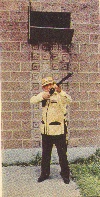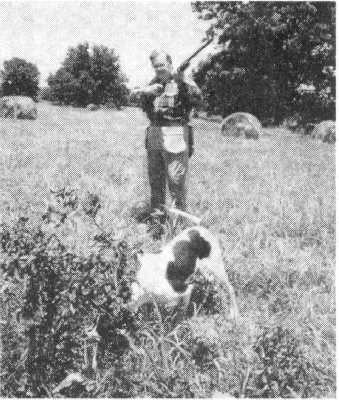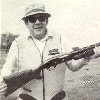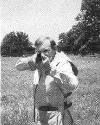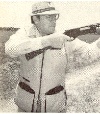TIPS ON SHOOTING TRAP
|
|
GRITS: What's the most important one ingredient in winning trapshoots? RUDY: Singles is somewhat of a marathon-type event. Handicap can be very difficult, especially at long yardage if you have a crosswind. And doubles shooting, which I think is king of the trapshooting game because it requires the most concentration and has perhaps the least room for error. You must have a gun that fits you, shoots where you look and in which you have confidence. You've got to have tremendous capability for concentration and learn to shoot one target or one pair at a time. The third thing, something we used to talk about years ago but which you don't hear much of anymore, is trigger timing. Trigger timing is something an experienced shooter needs in order to be a great shot. There are times when your line of sight through your eyes can be affected by wind, by shooting into the bright sun, etc., etc. Trigger timing is what it takes for your brain to say to your trigger finger that you are at the right place: Shoot. When you're razor-sharp on live birds, for instance, you know when to shoot both shots pretty quickly. There are other times when you know when to hold back. |
| Even at 16-yard shooting at trap, you can't shoot every target at the same speed you shot the last one. A little old thing called trigger timing can make all the difference. Many average good shots try to shoot everything at the same speed, and you simply can't do that effectively. There are too many factors - angle birds, straight aways, wind. Trigger timing is a terribly important thing. Your trigger-finger must hook up with your eyes and brain and gun barrel. | |
|
|
GRITS: What's your favorite singles gun?
RUDY: The 870 Remington pump. GRITS: What choke to you use on 16-yard targets? RUDY: Full choke or improved modified. I always like to know I have a dense enough pattern to break or kill what I'm shooting at. If I don't point it right, it's my fault. GRITS: What barrel length? RUDY: In an 870 a 30-inch barrel, which makes the gun as long, of course, as some single barrels and doubles, with 32-inch and 34-inch barrels. In single-barrel guns I prefer the 32-inch. GRITS: Do you shoot the same gun on singles and handicap? RUDY: Yes, I did, when I was shooting a lot. I shot everything with it, including doubles. GRITS: Any changes in equipment requirements over the years? RUDY: Well, you don't need the tight chokes for singles that we used to because of the better shells. I think that an improved modified choke is certainly all you need for 16-yard targets. GRITS: What load do you shoot on singles? RUDY: The 2 ? dram, 1 1/8 ounce of No. 8 shot. It's all you need. It's plenty fast, and it doesn't punish you. I shot light 8s all one year at 25 yards - then the maximum - had a 94.60 average, high for the U.S.. GRITS: Do you still shoot that load on handicaps? RUDY: Under normal conditions, yes. With a severe crosswind the 3 dram 7 ? shot helps at 27 yards. GRITS: What is your favorite load on doubles? RUDY: I like 2 ? dram with No. 8 ? shot for the first shot, because it's the only shot you can really set yourself for in trapshooting. It's the only time you should have your gun above the trap house when you call for the target. On the second bird I shoot 2 ? dram No. 8s. If there is a lot of wind, again, I often go to 7 ?s. GRITS: Is there any particular brand of shell you prefer? RUDY: All are good now. I think shooters tend to lean toward brands they've shot and been successful with. I tend to shoot Remington and Peters shells, since they won a lot of titles for me. In Europe, of course, you shoot shells we never heard of over here. They have a load that's 3 ? drams of powder, 1 ? ounces of shot . . . and it's a dandy load. It falls in between our Pigeon Load - 3 ? - 1 ? and our 3 ? - 1 ? high-velocity load. It's wonderful live-bird load and a great international trap load. It's a well-balanced load, and that means a lot. A 3 ? - dram powder charge blows 1 ? ounces of shot around pretty much, even with a collared wad. GRITS: What's the length of pull on your shotguns? RUDY: About 14 ? inches, but I shoot a Monte Carlo type stock on all of my competition guns - on my hunting guns I don't car whether I have it or not. On my straight-through Monte Carlo's I have about 1 7/16 inches at the comb and at the Monte Carlo, with a ?-inch Monte Carlo, and it has 2 ?- inches drop at the heel, with a down pitch of about 1 ? inches. I like a closed pistol grip, tight as I can get it, and a thin grip so you've got good control. That right hand does most of the work - not your left one. There's a three-way lock that makes you point properly. Your head and cheek on the gun, your right hand (if you're right handed), and the proper position on your shoulder. That's the triangle that does the work. The left hand just holds that gun up. Too many people hold the forearm too tight, which is like driving with your emergency brake on when you start moving after a fast bird. Relax that left hand Stance is important, but you've got to be locked in to your gun. That built-in pistol grip makes you tie that gun in to your shoulder and cheek, and it also pretty much eliminates flinching. GRITS: How in the world could a pistol grip eliminate flinching? RUDY: Because in a flinch you try to pull the trigger with your whole hand rather than with your trigger finger. If you get your hand jammed into a good tight pistol grip, the only thing that's going to work is that trigger finger. GRITS: Aren't these tight pistol grips hard to find? RUDY: Well, the old Etchen Specials are, because Dad didn't make that many. Some pretty good closed grips are available. The only fault I find with some of them is that they're too thick. You don't have good control over a gun if the grip is too thick. Not too thin, of course, but a well-proportioned, sleek circumference just behind the tang lets you get your hand around it so you feel you really have control of the gun. If the grip is too big I fell like the gun is pointing me rather than me pointing the gun. GRITS: Where do you hold on each of the trap positions? RUDY: Well, first, except for that first bird in doubles, always hold under the top of the house on all positions. On post No. 1, hold somewhere around the left corner of the house and below, so you can see where the bird goes the instant it leaves the trap house. If you hold above the house and the bird comes out from under your gun, you have a tendency to stab at it rather than make one complete swing and follow through. As you move stations just quarter your way. On No. 2, hold halfway between the left edge and the middle of the trap house. In the middle on No. 3; halfway between the middle and right edge on No. 4, and about the right edge on No. 5. Remember that a right-hand shooter has to push his gun when swinging to the right, and he invariably has a tendency to push the gun away from his face. Thus it's harder for him to keep his head down, face on the stock and follow through on that right-hand target. On a left-hand bird, it's natural for a right-hander to pull through with it since he's pulling his gun into his face. It is just the reverse for a left-hander. GRITS: Do you change the position of your gun for targets that are unusually high or low? RUDY: No. I still want to see that bird leave the house, and then I go after it. Use that trigger timing - slow up on the high birds and speed up on the low ones. GRITS: What is your sight picture relative to the target when your trigger timing is right? RUDY: Well, if your gun fits right and you've got a figure 8 sight-picture - that is the top of your center bead almost touching the bottom of your front bead - good trigger timing will touch it off just as you catch up with the target. Just as you swing through it. Wipe that bird out with your natural swing and follow through takes care of your lead. Measured lead is the worst thing in the world to work with, because one foot to one person looks like three to another. It's all relative. If you've got a good fast swing and make your follow through work, as you pass that bird you should pull the trigger and hit it in the middle. You don't have to be above or below it. Remember that you're throwing a 30-inch pattern, and you want to use the center of the pattern. I'd say that 60 to 70 percent of the trapshooters are using the top half of the patter, because the bird is climbing. Just throw your pattern a little higher and let the bird run into it. A lot more targets are missed under and behind than over and out front. All this is true if your trigger timing is good and you're shooting the target when it's still rising. You can't stand there and aim at it. It'll start falling and you'll raise your head. GRITS: How important is mounting the gun properly, the same way, each time? RUDY: Very important. That brings us back to the Monte Carlo stock. A person doesn't walk around all day with his head ducked down and turned to the side, but that's the way a lot of people shoot. That's not natural. The top of the recoil pad should be level with the top of your shoulder, with the pad in the indention of your shoulder. You should hold your head erect. If you've got a long neck or a high cheekbone that's where the Monte Carlo comes in, because it comes up to your cheek instead of you having to drop your head to the gun. It does the work for you, and anything you can let the gun do for you you'll be that much better off. That's just one more thing you don't have to remember every shot. Not everybody should shoot a Monte Carlo stock, but it helps most people and removes the tendency to lift your head. GRITS: Do you have days when you have trouble getting the gun in the same position each time? RUDY: Oh, sure. Didn't you ever pick up a golf club and look to see if it belonged to you? Yes, it happens in shooting, and I think it's mostly physical. If I've played a lot of golf or been active bowling or boating - used muscles I'm not accustomed to - the gun feels a little different. It can be something that you're wearing that makes the gun feel funny. I've got a couple of fancy shooting jackets which look great but which don't feel right when you mount the gun. GRITS: That could also take your mind off the actual shooting. RUDY: Yes, anytime you get concerned about something else, thinking about the office, breaking that concentration, you're getting close to a miss. Intense concentration is required. GRITS: Is your stance any different for doubles? RUDY: I open it up a bit, perfectly faced for the second target and with body coiled around for the first bird which only requires lifting the gun. I normally keep my right knee stiff and the left knee bent, and will bend that left knee a little more in doubles, so I can pivot off that left knee in a hurry after shooting the first shot. You're shooting it fast, and it's going up fast so you've got to shoot over it - cover it. Throw the shot up over it and then chase on over to that other bird, 'cause that's the one you want to run down with a fast, smooth swing and good trigger timing. GRITS: Do you shoot the right-hand bird first on station No. 3? RUDY: Normally, yes, just as on No. 1 and No. 2, since the percentage for a right hander is better swinging to the left. But on an adverse day, ad Dad used to say, shoot the lower bird first on post No. 3 if one target is flying lower than the other. GRITS: Will international trap become popular in this country? RUDY: I hope so. It seems to me that Europe is building better new shooters faster because international trap is difficult. The best shooters miss some targets, so there's no stigma to missing. As an indication of how tough it is, consider that there were only 23 perfect 25x25 rounds shot at the Cairo matches out of a possible 1600 opportunities. That was by 200 of the best shooters in the world - from 26 countries. GRITS: The expense of the 15-trap international layout is the prohibitive to most clubs. How about going to an oscillating trap for our shoots which gives various elevations? RUDY: I think they're going to have to . . . to make the game more difficult. I think it's time we made the traps harder, so that if you miss one you're not out of the race. Targets would have to be faster. GRITS: How can Europeans afford the pit layouts for international trap if we can't? RUDY: Well, there aren't as many clubs, and they don't keep their clubs open all the time. They'll have shooting seasons of three or four months at one club, then it'll close and another will open, something like our race tracks. GRITS: I was wondering why trap is so much more popular than skeet. Is it the cost of the range - two traps and houses? The cost of having to shoot four different gauges to fully compete? RUDY: Yes, and skeet - and I'm sure I'll incur the wrath of a lot of skeet shooters - skeet is a bit slow to be a good tournament sport. Now just to shoot to have fun, I'd rather take my .410 and go out to shoot skeet on Sunday. But for competition I prefer trap tournaments. You get more shooting in, and it's faster. Of course, international trap is even faster, with six shooters on a squad. Skeet is a wonderful game and great practice for wing shooting, and it requires more skill than many trap shooters give it credit. The very good skeet shooters are just as good gun pointers are the good trap shooters, and if you don't believe that just give a trap shooter a .410 and let him go out to shoot skeet. This "which is harder" business is relative. Like the guy who says there's nothing harder than shooting ducks. Well, he hasn't tried quail up in the jack oaks where you and I shot up in Oklahoma. |

